Do You Need a Permit?
Don’t forget that if your project is in or near a wetland resource area (which includes coastal banks and dunes), a permit may be required under the Wetland Protection Act (WPA). Projects in rare species habitat may also require a Massachusetts Endangered Species Act (MESA) permit since planting activities can alter habitat. For more detailed information on the regulatory requirements under the WPA and MESA, see CZM’s Coastal Landscaping in Massachusetts - Do You Need a Permit? page.
American Beachgrass
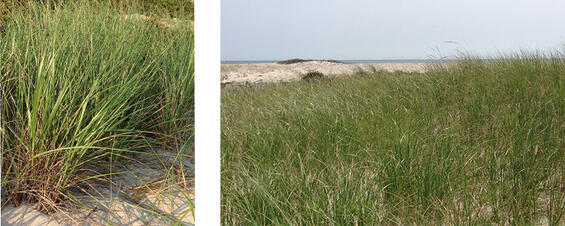
American beachgrass (Ammophila breviligulata) is the best species for the initial stabilization of fronting dunes (the dunes closest to the beach). The strong and fast-growing underground rhizomes (root-like underground stems) spread beneath the sand and give rise to many new plants, helping to colonize the species in dune environments. Beachgrass is also tolerant of intense heat, excessive sunlight, and drying winds and will grow on sandy or other course-grained soils. In New England, the best time to plant beachgrass is from late fall to April when the ground is not frozen—except in areas exposed to strong wind or waves, where it should be planted in early spring to reduce the likelihood that it will be washed or blown away in winter storms. (Also note that if the area to be planted is located in in rare species habitat, which for beachgrass projects is most likely to be shorebird or turtle nesting areas, the Natural Heritage and Endangered Species Program may require a permit under the Massachusetts Endangered Species Act. Permits often require conditions for planting, such as planting beachgrass before April 1 to protect shorebird breeding and nesting activities. For more information on permit requirements, see CZM’s Coastal Landscaping in Massachusetts - Do You Need a Permit? page.) Beachgrass tends to need the build-up of sand supplied by wind or waves to provide nutrients, avoid the build-up of thatch, and build healthy rhizomes. If sand over-topping does not happen naturally, fertilizers may be required to provide the necessary nutrients, and mowing may be necessary to prevent thatch.
(Full sun; dry, well-drained soils; drought tolerant; salt tolerant; deer and rabbit resistant; *** Availability Rating)
For more information, see:
- CZ-Tip - Dune Building with Beachgrass
- Lady Bird Johnson Wildflower Center’s Plant Database Page on Ammophila breviligulata
- Salicicola’s Ammophila breviligulata Plant Gallery
- United States Department of Agriculture’s Plant Fact Sheet on American Beachgrass (PDF, 48 KB)
American Dunegrass
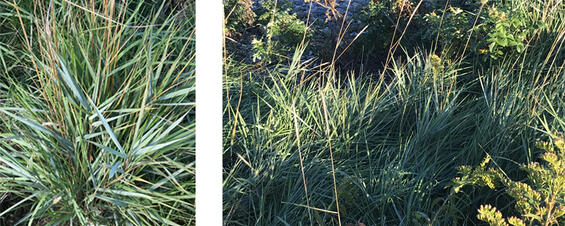
American dunegrass (Leymus mollis), also known as sea lyme-grass, is a native grass tolerant of salt spray and salty soils. Dunegrass grows to a height of 6 feet and forms clumps along coastal dunes and also on sand and gravel beaches. This grass species has green foliage and inconspicuous yellow flowers and brown fruits/seeds. The greatest bloom occurs in the late spring, with fruit and seed production starting in the summer and continuing until fall. American dune grass dies back under stress but comes back when conditions become favorable. Dunegrass has a long life span relative to most other plant species and a rapid growth rate. This grass is useful for soil stabilization and forage. The subspecies mollis is considered endangered in Massachusetts.
(Full sun; dry, well-drained soils; drought tolerant; salt tolerant; deer and rabbit resistant; ** Availability Rating)
For more information, see:
- Go Botany’s Plant Page on Leymus mollis
- iNaturalist’s Observation Page on American Dune Grass
- Lady Bird Johnson Wildflower Center’s Plant Database Page on Leymus mollis
- Natural Heritage & Endangered Species Program’s Sea Lyme-Grass Fact Sheet (PDF, 370 KB)
Beach Pea
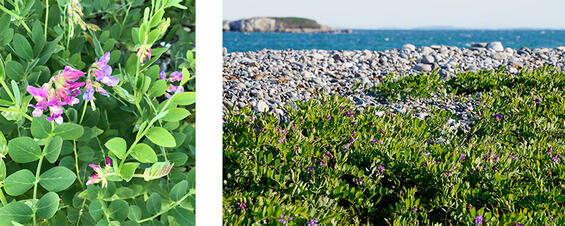
Beach pea (Lathyrus japonicus) is a sprawling perennial vine that grows in beach and dune environments. The leaves are divided into several segments and curling tendrils extend from leaf ends. Beach pea has showy purple or pink flowers and smooth, stalk-less seed pods that contain small peas. The peas are eaten by animals, such as deer, mice, and birds, but they are not safe for human consumption because they contain a paralyzing agent. The flowers are an attractive food sources for bees and butterflies. The beach pea's extensive native range is due to the ability of the seeds to remain viable in seawater up to 5 years. The plant can germinate when the tough seed shell is broken open by abrasion with the sand. Once established, the roots of the beach pea help bind soils of beaches and dunes.
(Full sun; dry to average, well-drained soils; drought tolerant; salt tolerant; * Availability Rating)
For more information, see:
- Go Botany’s Plant Page on Lathyrus japonicus
- iNaturalist’s Observation Page on Seaside Pea
- Lady Bird Johnson Wildflower Center’s Plant Database Page on Lathyrus japonicus
- Salicicola’s Lathyrus japonicus var. maritimus Plant Gallery
Big Bluestem
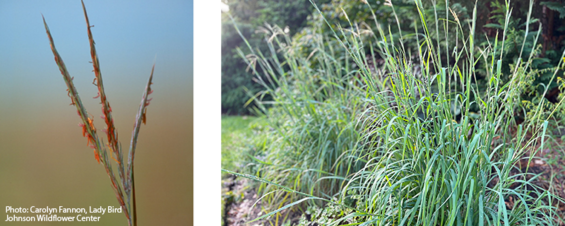
Big bluestem (Andropogon gerardii) (also known as turkey foot) is a tall, warm-season grass that grows 4 to 8 feet high. It has an upright stature, interesting flowers and seed heads that resemble a turkey’s foot, and leaves that change colors throughout the seasons. Big bluestem is drought tolerant once established, thrives in both heavy and sandy soils, and is moderately tolerant of salinity. This sod-forming grass will spread vigorously by rhizomes when provided with adequate moisture, while it will have a clumping, bunchgrass appearance under more arid conditions. Big bluestem can be used as an accent in native plant gardens, as a tall screen or hedge, or to stabilize soils and/or provide protection against wind erosion. Big bluestem also provides shelter and seeds for birds and insects.
(Full sun; dry to average, well-drained soils—adaptable to a variety of soil conditions; drought tolerant; somewhat salt tolerant; deer and rabbit resistant; **** Availability Rating)
For more information, see:
- Go Botany’s Plant Page on Andropogon gerardii
- Lady Bird Johnson Wildflower Center’s Plant Database Page on Andropogon gerardii
- Salicicola’s Andropogon gerardii Plant Gallery
- United States Department of Agriculture’s Plant Fact Sheet on Big Bluestem (PDF, 57 KB)
Black Grass
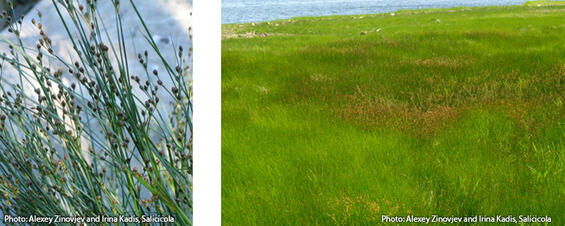
Black grass (Juncus gerardii), also known as salt meadow rush or salt marsh rush, is a loosely tufted, perennial herb. It grows from 1 to 2 feet tall and has rounded stems, grass-like leaves located on the lower half of the stem, and small green-brown flowers in dense spikes or in loose clusters. The flowering and fruiting period occurs from spring through summer. This grass spreads by rhizomes and forms extensive colonies in coastal estuaries and salt marshes just above the high tide line, where it is flooded only by the most extreme tides of each month. Black grass can also be grown on more inland sites. The rigid stems growing from fibrous roots make it a good plant for erosion control. Its adaptability to wet sites makes it a good plant for water or rain gardens, stormwater basins, low areas of the yard subject to flooding, and coastal gardens. The dense cover of black grass provides good shelter for birds and small mammals.
(Full sun; average to moist soils—tolerates a variety of soils, ranging from sand to clay, in a range of wetland and upland habitats; salt tolerant; *** Availability Rating)
For more information, see:
- Go Botany’s Plant Page on Juncus gerardii
- iNaturalist’s Observation Page on Saltmarsh Rush
- Lady Bird Johnson Wildflower Center’s Plant Database Page on Juncus gerardii
- Salicicola’s Juncus gerardii Plant Gallery
Blue Vervain
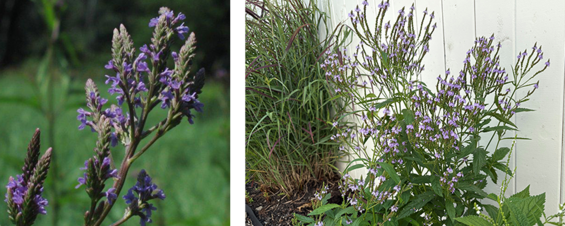
Blue vervain (Verbena hastata) is a tall, fast-growing perennial reaching up to 5 feet tall with panicles of purple-blue, blossoms that bloom in summer and pairs of toothed, lance-shaped leaves growing on stiff, hairy, square-shaped stems. This plant spreads by rhizomes and can easily self-seed. Blue vervain can be cut back in June to promote more compact growth. It can grow in degraded wetland habitats and is a useful alternative for invasive species, such as purple loosestrife. The flowers attract many pollinators, including bees, during the long blooming time, and the seeds are eaten by songbirds. Blue vervain has a long history of medicinal use among Native people and is still currently used to treat a variety of symptoms.
(Full to partial sun; average to wet soils—can tolerate brief periods of inundation; useful in rain gardens; somewhat salt tolerant but best planted away from salt spray; somewhat deer and rabbit resistant; **** Availability Rating)
For more information, see:
- Go Botany’s Plant Page on Verbena hastata
- Lady Bird Johnson Wildflower Center’s Plant Database Page on Verbena hastata
- Native Plant Trust’s Plant Page on Verbena hastata
- Salicicola’sVerbena hastata Plant Gallery
Bonesets, Common Boneset and Hyssop-leaved Boneset
Common boneset (left) and Hyssop-leaved boneset (right)
Bonesets, common boneset (Eupatorium perfoliatum) and hyssop-leaved boneset (Eupatorium hyssopifolium) are herbaceous, wildflower perennials with upright stems and clusters of many small, white, fragrant flowers that bloom from July to late fall. Both species can form colonies through the spread of underground rhizomes and are an attractive addition to a coastal landscape. Common boneset grows up to 6 feet tall, with umbel-shaped clusters of flowers and lance-shaped leaves. A native to floodplains and moist lowlands, this boneset prefers consistently moist soils rich in organic matter, making it a valuable addition to a rain garden or along wetlands, streams, or other waterbodies (though it will also adapt to average garden conditions). Hyssop-leaved boneset is shorter, growing 1 to 3 feet tall, with fine-textured clusters of flowers and narrower, green-gray leaves. This species is extremely drought and salt tolerant and can grow in a variety of well-drained soils, ranging from moist to dry sandy soils, making it useful for gardens near coastal beaches, dunes, and banks. Both species attract many pollinators and are host to over 40 species of caterpillars.
(Common boneset: Full to partial sun; medium to wet soils—prefers soils rich in organic matter; deer and rabbit resistant; best planted away from salt spray and wind; **** Availability Rating)
(Hyssop-leaved boneset: Full to partial sun; dry to medium to wet soils—can tolerate a wide range of soil conditions; drought tolerant; salt tolerant; deer and rabbit resistant; ** Availability Rating)
For more information, see:
- Go Botany’s Plant Pages onEupatorium perfoliatum and Eupatorium hyssopifolium
- Lady Bird Johnson Wildflower Center’s Plant Database Pages on Eupatorium perfoliatum and Eupatorium hyssopifolium
- Native Plant Trust’s Plant Pages on Eupatorium perfoliatum and Eupatorium hyssopifolium
- Salicicola’s Eupatorium perfoliatum and Eupatorium hyssopifolium Plant Galleries
Coastal Panic Grass
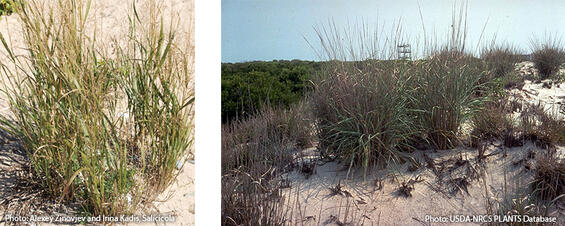
Coastal panic grass (Panicum amarum var. amarulum), a native grass that grows to heights of 3 to 6 feet, has a deep, fibrous root system that makes it an effective stabilizer of secondary sand dunes (the dunes landward of the dune closest to the beach). Panic grass will generally only survive where other species have initially stabilized the location. This grass will tolerate moderate saline overspray, but will not tolerate large deposits of sand. Due to its upright and hedge-like form and winter persistence, panic grass is useful for creating wind barriers and for creating wildlife cover on sandy coastal soils. If the coastal variety cannot be found at local nurseries, bitter panic grass (Panicum amarum) or switchgrass (Panicum virgatum) can also be planted on sandy soils. (not native; native to New Jersey south to Mexico)
(Full sun; dry to medium, well-drained soils—tolerates infertile sandy soils; drought tolerant; salt tolerant; * Availability Rating)
For more information, see:
- Go Botany’s Plant Page on Panicum amarum
- Lady Bird Johnson Wildflower Center’s Plant Database Page on Panicum amarum
- Salicicola’s Panicum amarum ssp. amarulum Plant Gallery
- United States Department of Agriculture’s Plant Guide on Coastal Panicgrass (PDF, 66KB)
Coastal Plain Joe-Pye Weed
Coastal plain Joe-Pye weed (Eutrochium dubium) grows 2 to 5 feet tall with coarsely toothed, lance-shaped leaves that grow in whorls around stout, finely haired, unbranched, purple stems. Dome-shaped corymbs of pink, lacy flowers appear mid-summer, and the seeds, which mature in the fall, are distributed by the wind. Though coastal plain Joe-Pye weed prefers moist, poorly drained, acidic soils—and is found in a variety of wetland habitats, including bogs, marshes, swales, and tidal estuaries—it is adaptable and can also grow in moist areas with sandy or gravelly soils. This adaptability, along with its tolerance to salt, makes coastal plain Joe-Pye weed a good choice for roadsides or within coastal gardens, provided adequate moisture is available. The plant spreads by both underground rhizomes and by seed, with seedlings establishing best on sites with little competition from other plants. The flowers attract a wide variety of pollinators, seeds are eaten by birds, and dry seed clusters are also used for nesting materials. This plant can be distinguished from its close relative, spotted Joe-Pye weed, by its more vibrant flower color, fewer flowers per head, and leaves in whorls of 3 to 4 (rather than 4 to 5).
(Full sun to partial shade; average to moist to wet, well-drained, nutrient-rich soils—intolerant of dry soils and drought; prefers slightly acidic soils; salt tolerant; deer and rabbit resistant; *** Availability Rating)
For more information, see:
- Go Botany’s Plant Page on Eutrochium dubium
- Lady Bird Johnson Wildflower Center’s Plant Database Page on Eutrochium dubium
- Native Plant Trust’s Plant Page on Eutrochium dubium
- Salicicola’sEutrochium dubium Plant Gallery
Eastern Showy Aster

Eastern showy aster (Eurybia spectabilis) is a tall (1 to 2 feet), native, perennial herb with lance-shaped leaves and showy clusters of flowers (violet-purple rays surrounding a yellow disc) that bloom from August to October. Showy aster forms clones and clumps and spreads by underground rhizomes with new shoots growing at the end of the rhizomes and bases of old stems. This aster is easily cultivated and becomes well established in dry, sandy, grassland habitats. Because eastern showy aster is tolerant of offshore winds and salt spray, it is often seen in pine barrens near the shore.
(Full sun to part shade; dry to moist, well-drained soils—tolerates infertile sandy soils; drought tolerant; salt tolerant; ** Availability Rating)
For more information, see:
- Go Botany’s Plant Page on Eurybia spectabilis
- iNaturalist’s Observation Page on Purple Wood Aster
- Lady Bird Johnson Wildflower Center’s Plant Database Page on Eurybia spectabilis
- Salicicola’s Aster spectabilis Plant Gallery
Golden Alexander
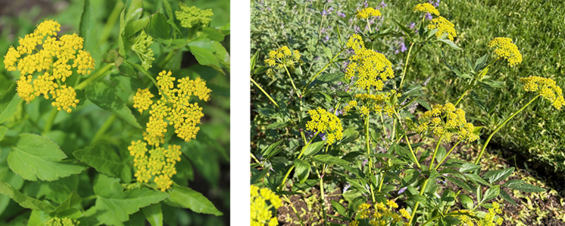
Golden Alexander (Zizia aurea) is a low-maintenance plant that grows 2 to 3 feet high, spreads quickly, readily self seeds, and is adaptable to many sun and soil conditions, making it a good choice for native gardens and meadows, along woodland edges, or in coastal gardens. The golden umbels, which are 3 to 4 inches wide, bloom in late spring when many other plants have not yet flowered, and the attractive seedheads can persist into winter. Golden Alexanders are an important food source for short-tongued insects that can easily reach the nectar in the small flowers and are a host plant for black swallowtail caterpillars.
(Full to partial sun—can tolerate shade; moist, well-drained soil—can tolerate both wet and dry conditions, provided plenty of moisture is available early in the growing season; moderately salt tolerant but best planted away from salt spray; deer and rabbit resistant; **** Availability Rating)
For more information, see:
- Go Botany’s Plant Page on Zizia aurea
- Lady Bird Johnson Wildflower Center’s Plant Database Page on Zizia aurea
- Native Plant Trust’s Plant Page on Zizia aurea
- Salicicola’sZizia aurea Plant Gallery
Little Bluestem
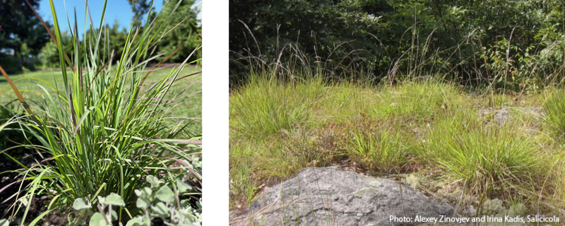
Little bluestem (Schizachyrium scoparium) is one of the most widely distributed native grasses in North America. It is a medium-height grass with plant height ranging from 18 inches on dry sites to 3 feet on fertile soils. Little bluestem begins growth in late spring and continues through the summer until the first killing frost. It will grow on a wide variety of soils, but is adapted to well-drained, medium-to-dry, infertile soils. The plant is tolerant of drought and shade but is fairly intolerant of flooding. Because of its adaptability to a wide range of soil conditions, little bluestem is useful as a component of re-vegetation mixes and for soil stability. Little bluestem provides cover for ground birds and small mammals and the numerous seeds provide food for songbirds.
(Full sun; dry to average, well-drained soils—tolerates infertile sandy soils and does not tolerate damp sites or heavy clay soils; drought tolerant; somewhat salt tolerant; deer resistant; **** Availability Rating)
For more information, see:
- Go Botany’s Plant Page on Schizachyrium scoparium
- Lady Bird Johnson Wildflower Center’s Plant Database Page on Schizachyrium scoparium
- Salicicola’s Schizachyrium scoparium Plant Gallery
- United States Department of Agriculture’s Plant Guide on Little Bluestem (PDF, 48 KB)
Mountain Mints, Hoary and Narrow-Leaf
Hoary mountain mint (left) and narrow-leaf mountain mint (right)
Mountain mints, hoary (Pycanthemum incanum) and narrow-leaf (P. tenuifolium) are two perennial wildflowers of the mint family with fragrant leaves, square stems, and clusters of small, lobed, whitish flowers. Hoary mountain mint grows 2 to 4 feet tall, with a silvery-white (hoary) tint to the upper leaves, bracts, flowers, and even the short hairs that cover the stems. The flowers bloom from June to August, and though mostly white, do have small purple spots. Narrow-leaf mountain mint grows 2 to 3 feet tall, with narrower, thread-like leaves, and smaller, wispier, white to lavender flowers that also bloom for much of the summer. Both grow well in exposed, dry soils, and spread easily through rhizomes and self-seeding, though narrow-leaf mountain mint grows in the driest, sunniest spots and is extremely drought tolerant. Both are somewhat salt tolerant, deer and rabbit resistant, and can also handle a little moisture and shade. Though these two mountain mint species form clumps rather than colonies, they provide useful soil cover to help prevent erosion (but if too aggressive, can be cut back to keep growth in check). As with all mountain mint species, these species are very fragrant, edible, and attract a wide variety of pollinators that feed on the flower nectar and pollen throughout the summer.
(Full sun to partial shade; dry to average soils; drought tolerant; extremely deer and rabbit resistant; somewhat salt tolerant; **** Availability Rating)
For more information, see:
- Go Botany’s Plant Pages on Pycanthemum incanumand P. tenuifolium
- Lady Bird Johnson Wildflower Center’s Plant Database Pages onPycanthemum incanum and P. tenuifolium
- Native Plant Trust’s Plant Pages on Pycanthemum incanum and P. tenuifolium
- Salicicola’s Pycanthemum incanum and P. tenuifolium Plant Galleries
Narrow-Leaf Evening Primrose, Sundrops
Narrow-leaf evening primrose, Sundrops (Oenothera fruticos) is an herbaceous perennial that grows 1 to 2 feet tall in a wide variety of conditions, including moist or dry open woods, meadows, maritime grasslands, rocky outcroppings, and disturbed fields and roadsides. Four-petaled, yellow flowers bloom on tall clusters of unbranched stems from April to July, followed by attractive seed pods and beautiful red foliage in the fall. Narrowleaf evening primrose is salt tolerant (and able to handle brackish soils), drought tolerant, and does best in full to part sun to avoid getting leggy. Primroses are wildlife-friendly perennials, providing nectar for hummingbirds, butterflies, and specialized native bees, and act as a larval host plant for the pink primrose moth. Two subspecies grow in New England with differing habitats—subspecies glauca is more often found in dry, open, sandy, inland habitats, whereas subspecies fruticosa is commonly found in or adjacent to tidal habitats.
(Full sun to partial shade; average to dry, well-drained soils; drought tolerant; salt tolerant; deer and rabbit resistant; ** Availability Rating)
For more information, see:
- Go Botany’s Plant Page on Oenothera fruticosa
- Lady Bird Johnson Wildflower Center’s Plant Database Page on Oenothera fruticosa
- Native Plant Trust’s Plant Page on Oenothera fruticosa
- United States Department of Agriculture’s Plant Fact Sheet on Narrowleaf Evening Primrose (PDF, 79 KB)
New York Aster
New York aster (Symphyotrichum novi-belgii, formerly known as Aster novi-belgii) is a many-stemmed, upright, clumping aster that grows 1 to 4 feet tall, with smooth, long (6 inch), narrow, gray-green leaves and prolific fall flowers that range in color from bright pink to deep purple with yellow centers. New York aster is salt tolerant and grows in slightly brackish marshes, borders of salt marshes and inland marshes, and other moist, sunny, coastal sites but also can flourish in inland areas. It spreads by creeping rhizomes and is useful in rain gardens, seaside gardens, sunny meadows, and even front borders. A late-season pollinator favorite, this aster blooms from late July through October and offers a valuable nectar source for native bees and butterflies, including monarchs. The plant also hosts caterpillars of many moths, and the dried seeds provide food for birds. Plants can be pruned back before June to control the height and promote a more compact form, and clumps can be divided to prevent die-out within centers and reduce powdery mildew caused by overcrowding.
(Full sun; average to moist, well-drained soils—thrives in sandy or clay soils; salt tolerant; somewhat drought tolerant but best with adequate moisture; somewhat deer and rabbit resistant; **** Availability Rating)
For more information, see:
- Go Botany’s Plant Page on Symphyotrichum novi-belgii
- Lady Bird Johnson Wildflower Center’s Plant Database Page on Symphyotrichum novi-belgii
- Native Plant Trust’s Plant Page on Symphyotrichum novi-belgii
- Salicicola’s Symphyotrichum novi-belgii Plant Gallery
Pennsylvania Sedge
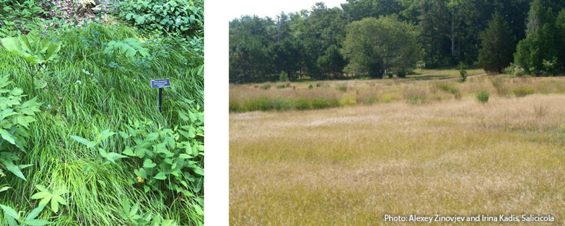
Pennsylvania sedge (Carex pensylvanica) is a low, clump-forming, grass-like perennial growing 6 to 12 inches high. This native plant with pale green, arching leaves and a cluster of brown seed capsules high on the stem forms soft, 15-inch clumps that spread quickly. This sedge grows well in either partially sunny or shady areas, prefers average-to-dry soils, binds the soil with its dense roots, and remains lush even in sandy soils. Though noninvasive, the creeping foliage can form dense mats that function well as a traditional lawn, yet will not require mowing, fertilizing, or chemicals. If mowing is preferred, this sedge looks best cut two to three times per year at 3 to 4 inches high. Pennsylvania sedge can be planted from plugs 6 to 12 inches on center in the fall or spring. Its rhizomatous, turf-forming habit provides excellent ground cover for wildlife, and the seeds are a source of food for a number of birds and small mammals.
(Partial shade to shade; dry to medium, well-drained soils—does well in dry woodlands or sandy openings in wooded areas; drought tolerant; best planted away from salt spray; deer resistant; **** Availability Rating)
For more information, see:
- Go Botany’s Plant Page on Carex pensylvanica
- Lady Bird Johnson Wildflower Center’s Plant Database Page on Carex pensylvanica
- Missouri Botanical Garden’s Plant Page on Carex pensylvanica
- Salicicola’s Carex Pensylvanica Plant Gallery
Pink Tickseed
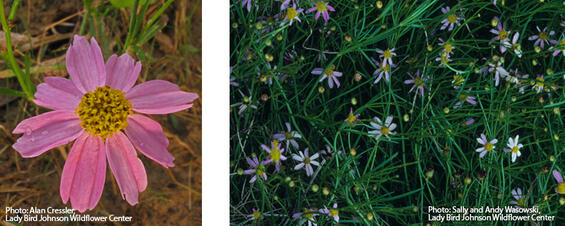
Pink tickseed (Coreopsis rosea) is a low-maintenance, fine-textured, perennial reaching a height and spread of 1 to 2 feet. The grass-like, green leaves give an open and delicate appearance to the plant, while the pink, daisy-like flowers bloom profusely from June through September. This plant prefers full sun and medium moisture, yet can tolerate dry, shallow, and rocky soil. Plants can spread by rhizomes and can easily self-seed to form a dense bushy groundcover. The flowers attract butterflies and the seeds are eaten by birds. Pink tickseed is useful as an accent in native gardens or rock gardens, as ground cover, and as edges for borders, foundations, and paths.
(Full sun; consistently moist, well-drained soils—but can tolerate a wide range of habitats, including pine barrens, moist open woods, and shores of waterbodies; prefers slightly acidic soils; best planted away from salt spray; deer resistant; ** Availability Rating)
For more information, see:
- Go Botany’s Plant Page on Coreopsis rosea
- Lady Bird Johnson Wildflower Center’s Plant Database Page on Coreopsis rosea
- Missouri Botanical Garden’s Plant Page on Coreopsis rosea
- Salicicola’s Coreopsis rosea Plant Gallery
Poverty Dropseed
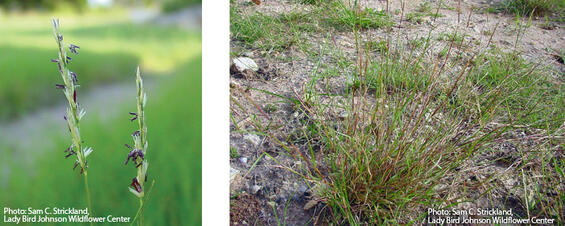
Poverty dropseed (Sporobolus vaginiflorus) is a native, annual grass that grows about 8 to 12 feet tall and wide in a tuft-forming cluster. The culms, which are light greenish-purple and wiry, terminate in a spike-like panicle with spikelets that are pink, purple, or pale green and often shiny. Most plant growth occurs during the summer, while the blooming period occurs during the early fall. Poverty dropseed grows best in full sun, dry conditions, and barren soil containing sand or gravel, and can withstand drought conditions and drying winds. Poverty dropseed primarily spreads by reseeding itself. The seeds are also a potential food source for birds, particularly during the winter.
(Full sun; well-drained soils—prefers sparsely vegetated sand or gravelly soils and rock outcrops; drought tolerant; best planted away from salt spray; * Availability Rating)
For more information, see:
- Go Botany’s Plant Page on Sporobolus vaginiflorus
- iNaturalist’s Observation Page on Poverty Dropseed
- Lady Bird Johnson Wildflower Center’s Plant Database Page on Sporobolus vaginiflorus
- Salicicola’s Sporobolus vaginiflorus Plant Gallery
Prairie Dropseed
Prairie dropseed (Sporobolus heterolepis) is a long-lived, warm-season, clump-forming grass that grows 2 to 3 feet high with slender stems on an arching, fountain-like, green, tufted base. The attractive, airy, pinkish-tan flowering panicles, which have a cilantro-like fragrance, appear above the foliage from August through October. In the fall, the foliage turns golden and the smooth, rounded seeds (achenes) drop to the ground (giving the plant its name). Prairie dropseed grows in dry, sandy, and gravelly soils but can tolerate regular garden soil if well drained. This grass is useful for borders and meadows, and its fibrous root system can help stabilize soils and prevent erosion. Prairie dropseed is a host plant for many species of butterflies and moths and provides nesting areas for native bees and seeds for birds.
(Full to partial sun; dry to average, well-drained soils—can tolerate a wide range of soils, including sand and clay; drought tolerant; somewhat salt tolerant; deer resistant; **** Availability Rating)
For more information, see:
- American Beauties’ Native Plants Page on Sporobolus heterolepis
- Go Botany’s Plant Page on Sporobolus heterolepis
- Lady Bird Johnson Wildflower Center’s Plant Database Page on Sporobolus heterolepis
- Native Plant Trust’s Plant Page on Sporobolus heterolepis
Purple Lovegrass
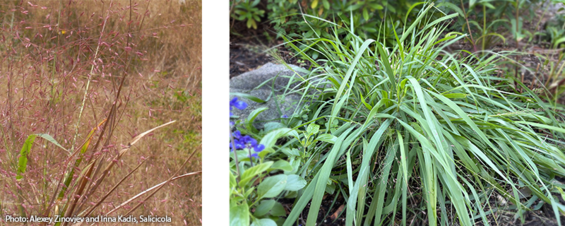
Purple lovegrass (Eragrostis spectabalis) is a native, warm season, perennial bunchgrass that grows from 1 to 3 feet in height and width (though some commercial varieties can reach heights up to 10 feet). This low-maintenance grass is tolerant of drought and full sun and performs best in sandy or gravelly soils in hot, dry locations. The showy reddish-purple flowers bloom from July to August and are valued for their soft, hazy appearance when grown in mass and for dry flower arrangements. If not cut, the flower heads tends to break off and blow like tumbleweeds, dispersing seeds as they go (deadheading the seed heads will therefore limit the reseeding and spread of this grass in the landscape). The grass can also spread by rhizomes under the ground, which makes it an effective groundcover or for mass plantings.
(Full sun; dry to moist, well-drained soils—prefers dry sand or gravelly soils; drought tolerant, moderately salt tolerant but best planted away from salt spray; deer resistant; **** Availability Rating)
For more information, see:
- Go Botany’s Plant Page on Eragrostis spectabalis
- Lady Bird Johnson Wildflower Center’s Plant Database Page on Eragrostis spectabalis
- Salicicola’s Eragrostis spectabalis Plant Gallery
- United States Department of Agriculture’s Plant Fact Sheet on Purple Lovegrass (PDF, 56 KB)
Red Columbine
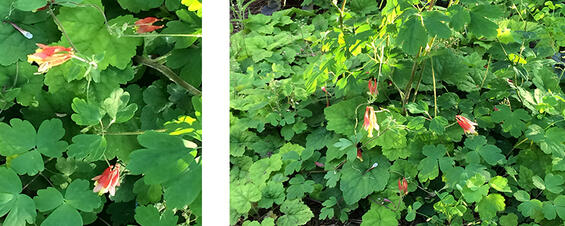
Red columbine (Aquilegia canadensis) is a perennial herb growing up to 2 feet tall with attractive, red and yellow, downward-facing tubular flowers that bloom from March to July. Red columbine can grow in a wide range of habitats from rich woods to rocky cliffs to beach borders. This columbine is a popular garden perennial because it is hardy, tolerates shade and a wide range of soil conditions, and can easily regenerate by seed. The flowers provide an important source of nectar for hummingbirds, bees, and butterflies.
(Partial sun to shade; dry to moist, well-drained soils—tolerates a wide range of soils provided drainage is good; best planted away from salt spray; deer resistant; **** Availability Rating)
For more information, see:
- Go Botany’s Plant Page on Aquilegia canadensis
- Lady Bird Johnson Wildflower Center’s Plant Database Page on Aquilegia canadensis
- Salicicola’s Aquilegia canadensis Plant Gallery
- United States Department of Agriculture’s Plant Guide on Red Columbine (PDF, 71KB)
Red Fescue
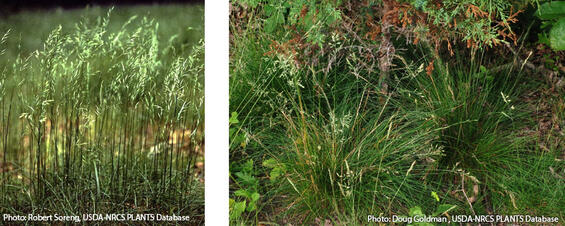
Red fescue (Festuca rubra) is a cool season, sod-forming grass that grows up to 2 feet tall with bright green, wiry leaves and narrow panicle seed heads. Red fescue is hardy, adapted to sandy and acidic soils, and has a high tolerance for cold temperatures and shade, a moderate tolerance for drought and trampling, and a low tolerance for heat. Red fescue does not require much fertilizer or excessive amounts of water to grow. This grass is extremely useful for stabilizing the slopes of waterways and banks, as well as providing turf for lawns, athletic fields, and playgrounds. Red fescue is often found in grass seed mixtures, particularly those for shady areas. (Festuca rubra ssp. pruinosa is considered native to the coastal counties of Massachusetts; all other subspecies are not considered native)
(Full sun to partial shade; dry to average, well-drained soils; tolerant of cold and shade; moderately drought tolerant; somewhat salt tolerant; **** Availability Rating)
For more information, see:
- Go Botany’s Plant Page on Festuca rubra
- Lady Bird Johnson Wildflower Center’s Plant Database Page on Festuca rubra
- Salicicola’s Festuca rubra Plant Gallery
- United States Department of Agriculture’s Plant Fact Sheet on Red Fescue (PDF, 63KB)
Saltgrass
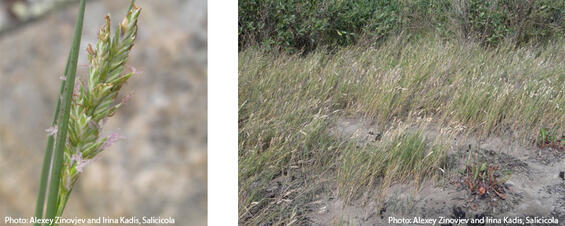
Saltgrass (Distichlis spicata) is a gray-green, perennial grass that grows from 1 to 3 feet high with wiry, stiff stems and flat, short leaves along the stems. The yellowish flower panicles bloom from June to October and turn tan as they dry. Saltgrass forms dense mats, spreading by rhizomes and sometimes stolons (horizontal stems near the soil surface) and can rapidly colonize new areas. This grass commonly forms patches in the high salt marsh but can also be found in the troughs of back dune areas and in salt or mud flats along the coast. Though well adapted to wet sites, saltgrass shows a high drought tolerance and has been documented as growing in drier forest sites and desert scrub habitats. Saltgrass provides excellent nesting grounds for birds, fish, and larvae of many species of marine invertebrates.
(Full sun; dry to moist soils—tolerates a wide range of habitat types and plant communities, but in Massachusetts, it prefers salt and brackish coastal marshes; moderately drought tolerant; salt tolerant; ** Availability Rating)
For more information, see:
- Go Botany’s Plant Page on Distichlis spicata
- Lady Bird Johnson Wildflower Center’s Plant Database Page on Distichlis spicata
- Salicicola’s Distichlis spicata Plant Gallery
- United States Department of Agriculture’s Plant Fact Sheet on Saltgrass (PDF, 264 KB)
Saltmarsh (Smooth) Cordgrass
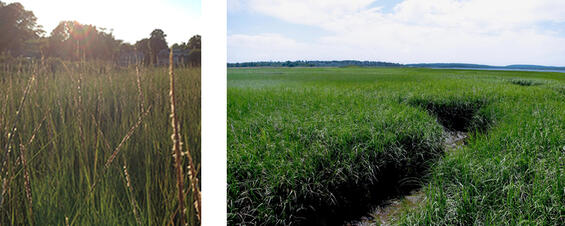
Saltmarsh cordgrass (Spartina alterniflora) is a long-lived, perennial grass primarily found on the tidal areas of open coastal marshes. The plant, which spreads by long, hollow rhizomes, grows to 7 feet tall with flat leaf blades that are typically 12 to 20 inches long. Flower spikes appear late summer through fall. Saltmarsh cordgrass, which is tolerant of regular tidal inundation and salt- or brackish-water, is often planted for shoreline protection and tidal marsh restorations (the root system helps stabilize the marsh mud). Hand planting of the stems is the best way to establish plants—up to 2 feet of lateral spread can be expected annually. Besides acting as habitat for other plants and animals, the roots and shoots of cordgrass provide food for wetland mammals and waterfowl.
(Full sun; moist soils—prefers sandy soils in estuarine and marine tidal wetland habitats; tolerant of fluctuating water depths and salinity; ** Availability Rating)
For more information, see:
- Go Botany’s Plant Page on Spartina alterniflora
- Lady Bird Johnson Wildflower Center’s Plant Database Page on Spartina alterniflora
- Salicicola’s Spartina alterniflora Plant Gallery
- United States Department of Agriculture’s Plant Fact Sheet on Smooth Cordgrass (PDF, 58KB)
Saltmeadow Cordgrass
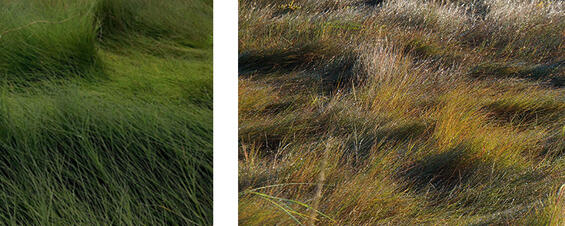
Saltmeadow cordgrass (Spartina patens), a native, perennial grass, grows from 1 to 3 feet tall and spreads extensively by long, slender rhizomes. Although typically associated with tidal salt marshes, saltmeadow cordgrass also naturally occurs in back dune areas, particularly within dune troughs (low points between dunes). It is dominant in these areas since most other sand dune species cannot tolerate wet- to saturated-soil conditions. Saltmeadow cordgrass will tolerate irregular inundations with significant amounts of salinity. The trailing rhizomes of saltmeadow cordgrass are slender but form dense mats near the surface, offering effective sand dune stabilization. It can be grown and established on normal sites using freshly harvested stems (culms) or containerized plants. From late June to October, an inflorescence emerges at the end of the stem. Saltmeadow cordgrass also provides food and cover for a number of animals.
(Full sun; moist soils—prefers sandy soils within brackish marshes, high marshes, low dunes, and sand flats; tolerant of fluctuating water depths and salinity; ** Availability Rating)
For more information, see:
- Go Botany’s Plant Page on Spartina patens
- Lady Bird Johnson Wildflower Center’s Plant Database Page on Spartina patens
- Salicicola’s Spartina patens Plant Gallery
- United States Department of Agriculture’s Plant Fact Sheet on Saltmeadow Cordgrass (PDF, 88KB)
Sea Lavender
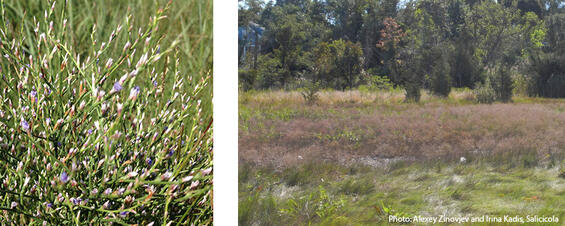
Sea lavender (Limonium carolinianum), also known as lavender thrift or seaside thrift, is a perennial, saltmarsh plant that grows 1 to 2 feet high and has abundant, small, pale-purple flowers on branching clusters. Sea lavender blooms create the appearance of a delicate purple mist on the salt marsh during the late summer and early fall. This plant is adapted to a wide range of soil textures, but requires plentiful moisture. The moderate growth of sea lavender is primarily through its horizontal rhizomes, rather than seed. Because sea lavender's attractive calyx (the outer enclosure of the flower) remains on the plant when the true flowers are gone, it is often grown for the flowers and used in dried flower arrangements.
(Full sun to partial shade; moist, but well-drained soils—grows in estuarine and marine tidal wetlands, intertidal areas, and coastal beaches; tolerant of fluctuating water depths and salinity; ** Availability Rating)
For more information, see:
- Go Botany’s Plant Page on Limonium carolinianum
- iNaturalist’s Observation Page on Carolina Sea Lavender
- Lady Bird Johnson Wildflower Center’s Plant Database Page on Limonium carolinianum
- Salicicola’s Limonium caralinianum Plant Gallery
Sea Rocket

Sea rocket (Cakile edentula) is a native perennial, growing 6 to 20 inches in size, with pale lavender to white flowers that bloom from July to September. Sea rocket is found on beaches above the high tide line and sometimes in dunes. Sea rocket prefers sunny locations with sandy, well-drained soils. It can grow in nutritionally poor soil and can tolerate strong winds. The stems and leaves are fleshy. The flowers are pollinated by bees, flies, beetles, moths, and butterflies. The seeds are dispersed through the fruits that break into segments and are able to travel distances in the water before washing ashore, breaking open, and generating new growth.
(Full sun; dry, well-drained soils—grows on sandy beaches and gravelly or rocky shorelines; drought tolerant; salt tolerant; * Availability Rating)
For more information, see:
- Go Botany’s Plant Page on Cakile edentula
- iNaturalist’s Observation Page on American Searocket
- Lady Bird Johnson Wildflower Center’s Plant Database Page on Cakile edentula
- Salicicola’s Cakile edentula Plant Gallery
Seabeach Sandwort
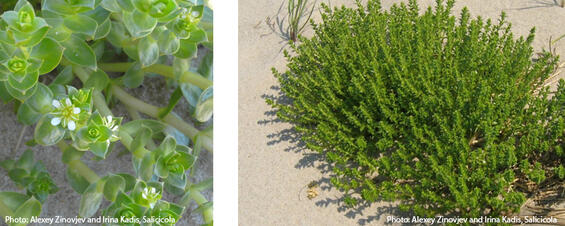
Seabeach sandwort (Honckenya peploides) is a hardy, perennial herb with numerous stems and succulent leaves that grows from 4 to 16 inches high. The honey-scented, white-to-pale-yellow flowers bloom from May to August and are pollinated by insects, wind, wind-blown sand, or self-pollination. Seabeach sandwort is commonly found growing on sandy coastal beaches and dunes and is tolerant of salt spray and occasional salt-water immersion. Seabeach sandwort requires an open, sunny position and prefers well-drained, light-sandy or medium loamy soils, both of which can be nutritionally poor. This plant spreads by rhizomes and is able to effectively form clumps or mats, which is particularly useful for beach and dune stabilization and dune formation.
(Full sun; dry to average, well-drained soils—tolerates nutrient-poor, sandy environments, including coastal beaches and dunes; drought tolerant; salt tolerant; * Availability Rating)
For more information, see:
- Go Botany’s Plant Page on Honckenya peploides
- iNaturalist’s Observation Page on Sea Sandwort
- Lady Bird Johnson Wildflower Center’s Plant Database Page on Honckenya peploides
- Salicicola’s Honckenya peploides Plant Gallery
Seaside Goldenrod

Seaside goldenrod (Solidago sempervirens) is a native perennial that is well adapted to the landward side of fronting dunes, low secondary dunes, and edges of salt marshes. The fleshy, waxy leaves growing abundantly along the entire length of the stem help retain moisture that would otherwise be lost to the drying effect of salt spray. The plant typically grows 3 to 5 feet tall. In late winter, red leaves arise through the sand surface and soon become dark green. In late summer and early fall, the bright yellow flowers—which are larger than those of the typical goldenrod—provide a striking contrast to the green vegetation.
(Full sun; dry to moist, well-drained soils—tolerates nutrient-poor, sandy soils and standing water; drought tolerant; salt tolerant; deer resistant; *** Availability Rating)
For more information, see:
- Go Botany’s Plant Page on Solidago sempervirens
- Lady Bird Johnson Wildflower Center’s Plant Database Page on Solidago sempervirens
- Salicicola’s Solidago sempervirens Plant Gallery
- United States Department of Agriculture’s Plant Guide on Seaside Goldenrod (PDF, 293 KB)
Swamp Mallow
Swamp mallow (Hibiscus moscheutos) is a shrub-like, wetland perennial that grows 3 to 6 feet tall and 2 to 4 feet wide, with large heart-shaped leaves on numerous sturdy stems that arise from a single base. The showy, 5-petaled, red, pink, white, or bicolor hibiscus flowers bloom continuously—individual blooms last only a day, but the plant will continue flowering from midsummer to the first frost. Swamp mallow prefers moist, slightly acidic, organic soils of low, wet sites, such as edges of wetlands and waterbodies. The plant spreads by seeds or can be divided, and stems can be cut back to encourage a more compact appearance. Swamp mallow can be planted in low, wet areas of a yard, along salt marshes, streams or ponds, within rain gardens, or as a temporary summer privacy screen or hedge. This plant also provides seeds for songbirds and attracts a variety of hummingbirds, butterflies, and specialized bees.
(Full sun to partial shade; average to wet soils, prefers slightly acidic soils; salt tolerant; *** Availability Rating)
For more information, see:
- Go Botany’s Plant Page on Hibiscus moscheutos
- Lady Bird Johnson Wildflower Center’s Plant Database Page on Hibiscus moscheutos
- Native Plant Trust’s Plant Page on Hibiscus moscheutos
- Salicicola’sHibiscus moscheutos Plant Gallery
Sweet Goldenrod
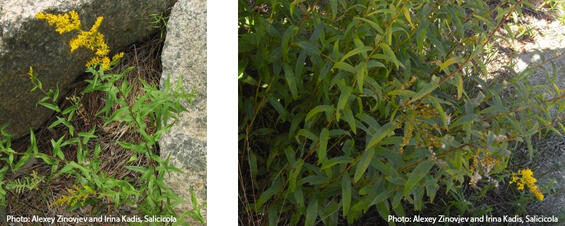
Sweet goldenrod (Solidago odora)—also known as licorice goldenrod because the leaves give off this scent when crushed—is a clump-forming perennial herb that grows from 2 to 5 feet high. The dark-green, lance-shaped leaves can be used in teas and as an herbal remedy for many ailments. The flowers—large, bright yellow terminal clusters—appear in late summer and continue to bloom into mid fall. Sweet goldenrod is well adapted to dry, open habitats and acidic and sandy soils and is extremely drought tolerant once established. It tolerates partial shade, but performs best in full sun. Sweet goldenrod is commonly found in the woods and fields across the coastal regions of Massachusetts but can be used for borders or in flower and herb gardens. Goldenrods provide nectar for bees and butterflies and seeds for many song birds—and contrary to popular belief, it is ragweed, not goldenrod, that causes seasonal allergies.
(Full sun to partial shade; dry to medium, well-drained soils—tolerates nutrient-poor, sandy soils and light shade, including within dry open woods and pinelands; drought tolerant; deer resistant; *** Availability Rating)
For more information, see:
- Go Botany’s Plant Page on Solidago odora
- iNaturalist’s Observation Page on Sweet Goldenrod
- Lady Bird Johnson Wildflower Center’s Plant Database Page on Solidago odora
- Salicicola’s Solidago odora Plant Gallery
Switchgrass

Switchgrass (Panicum virgatum) is a perennial, clump-forming, warm-season grass, 3 to 6 feet high, with open, lacy sprays and reddish-purple seedheads. New foliage emerges fresh from the base in spring, and the bright green leaves that grow along the stem turn bright yellow in the fall. Switchgrass is well adapted to a wide range of soil conditions, ranging from shallow and dry soils to poorly drained sites and even brackish marshes. Its adaptability to both wet and dry conditions makes it an appropriate choice for a rain garden. Switchgrass, with its deep, fibrous roots, is an excellent soil stabilizer on banks, sand dunes, and other erosion-prone areas. It can also provide a low windbreak for other plants. Switchgrass provides cover, nesting material, and seeds for birds and small mammals.
(Full sun to partial shade; dry to moist, well-drained soils—tolerates a wide range of soil conditions, including sand and clay; tolerates standing water and drought; moderately salt tolerant; somewhat deer and rabbit resistant; **** Availability Rating)
For more information, see:
- Go Botany’s Plant Page on Panicum virgatum
- Lady Bird Johnson Wildflower Center’s Plant Database Page on Panicum virgatum
- Salicicola’s Panicum virgatum Plant Gallery
- United States Department of Agriculture’s Plant Fact Sheet on Switchgrass (PDF, 66 KB)
Wavy Hairgrass

Wavy hairgrass (Deschampsia flexuosa) is a fine-textured, cool-season bunchgrass that grows from 8 to 12 inches high. It has delicate, spray-like spring flower heads on wavy, hair-like evergreen stems. The soft texture and tiny masses of seed heads effectively catch the sunlight. Wavy hairgrass is tolerant of shade, is very winter hardy, offers fall and winter seeds for birds and small mammals, and has a clump-forming habit that provides protective cover for many species of wildlife.
(Partial shade to full shade; dry to moderately moist, well-drained soils—tolerates a wide range of soil and light conditions, including dry shade; prefers slightly acidic soils; drought tolerant; best planted away from salt spray; *** Availability Rating)
For more information, see:
- Go Botany’s Plant Page on Deschampsia flexuosa
- Lady Bird Johnson Wildflower Center’s Plant Database Page on Deschampsia flexuosa
- Native Plant Trust’s Plant Page on Deschampsia flexuosa
- Salicicola’s Deschampsia flexuosa Plant Gallery
White Goldenrod, Silverrod
White goldenrod, silverrod(Solidago bicolor), which grows 1 to 3 feet tall and 1 to 2 feet wide, is one of the only goldenrods with white flowers. The flowers, which appear between July and October, consist of many small flowers (with white rays and light-yellow center disks) that spiral up the unbranched stems. White goldenrod has a narrow, upright habit, and elliptical green leaves that are 3 to 6 inches long at the base and then get smaller toward the top of the silvery-haired stems. This goldenrod grows in poor soils or heavy clay, disturbed sites, meadows, and woodlands and is very drought tolerant and adaptable to many garden conditions. Like other goldenrods, this species is a host plant for over 100 species of caterpillars, an important source of nectar and pollen for specialized bees and other insects, and a valuable seed source for songbirds.
(Full sun to partial shade; dry to average, well-drained, nutrient-poor soils; drought tolerant; deer and rabbit resistant; somewhat salt tolerant but best planted away from salt spray and wind; ** Availability Rating)
- Go Botany’s Plant Page on Solidago bicolor
- Lady Bird Johnson Wildflower Center’s Plant Database Page on Solidago bicolor
- Native Plant Trust’s Plant Page on Solidago bicolor
- Salicicola’s Solidago bicolor Plant Gallery
Woodland Sunflower
Woodland sunflower (Helianthus divaricatus) is a shade-tolerant, herbaceous wildflower that grows 5 to 7 feet high with smooth to slightly toothed, opposite leaves on upright stems. The 2-inch sunflowers, which consist of 8 to 15 bright yellow rays with darker yellow center disks, appear from July to September and are followed by the sunflower seeds that are readily eaten by many species of birds. This sunflower forms colonies through creeping rhizomes and grows along forest edges, meadows, and woodlands in average well-drained soils, and sometimes in poor, sandy soils. The relatively tall growth and quick-forming colonies provide good ground cover for exposed soils, as well as shelter for wildlife (woodland sunflower can be divided every 3 to 4 years to control its spread if it becomes too aggressive). The flowers provide nectar and pollen for a wide variety of insects and are preferred by the endangered karner blue butterfly.
(Full sun to partial shade; average to dry, well-drained soils; drought tolerant; slightly salt tolerant but best planted away from salt spray and wind; *** Availability Rating)
For more information, see:
- Go Botany’s Plant Page on Helianthus divaricatus
- Lady Bird Johnson Wildflower Center’s Plant Database Page on Helianthus divaricatus
- Native Plant Trust’s Plant Page on Helianthus divaricatus
- Salicicola’sHelianthus divaricatus Plant Gallery
Yellow Plume Grass
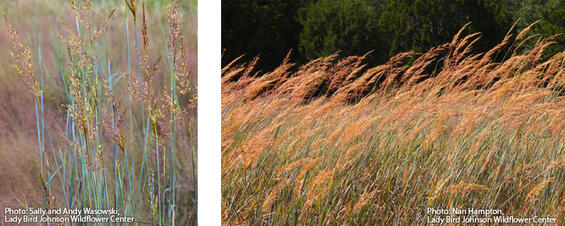
Yellow plume grass (Sorghastrum nutans) is a tall, warm-season grass that grows from 3 to 8 feet high. In the fall, the slender, blue-green leaves of this hardy upright grass turn yellow, and the towering stiff stems topped with narrow, plume-like auburn flower heads turn deep orange or purple. Yellow plume grass prefers full sun, is tolerant of a wide range of soil types, and is moderately drought and salinity tolerant. Yellow plume grass can be grown in bunches or as single stems mixed with other grasses and is useful for erosion control. The seeds provide food for birds and mammals and the grass provides excellent nesting material and cover for wildlife.
(Full sun; dry to moist, well-drained soils—tolerates a wide range of soil conditions, including sand and clay; moderately drought tolerant; moderately salt tolerant but best planted away from salt spray; deer and rabbit resistant; **** Availability Rating)
For more information, see:
- Go Botany’s Plant Page on Sorghastrum nutans
- Lady Bird Johnson Wildflower Center’s Plant Database Page on Sorghastrum nutans
- Salicicola’s Sorghastrum nutans Plant Gallery
- United States Department of Agriculture’s Plant Guide on Indiangrass (PDF, 70 KB)
Availability Rating Key
**** - Widely available at large commercial garden centers, as well as at specialty nurseries and through online purchase.
*** - Widely available at specialty nurseries and through online purchase, but only occasionally found at garden centers.
** - Occasionally available at specialty nurseries and through online purchase and difficult to find at garden centers.
* - Selectively available through specialty nurseries and through online purchase and difficult to find at garden centers.
See Where to Purchase Native Plants for Massachusetts nurseries and online options. If you cannot find a plant you are interested in, contact your local garden center and other outlets to help encourage future availability.